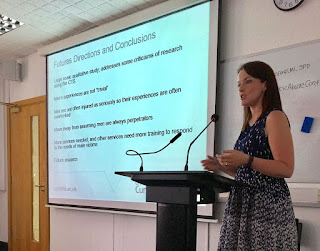Bullying and Intimate Partner Violence: A Literature Review
 |
| Lauren Bolam |
The main aim
of my PhD is to explore the predictive power of bullying and its development
trajectories on abusive and controlling behavior in opposite-sex and same-sex
relationships. The studies are in their final data collection period.
Intimate Partner Violence (IPV) is a serious
societal problem (Centres for Disease Control [CDC], n.d.), and there is a
wealth of research conducted from a range of different disciplines to
understand this issue. The World Health Organisation (WHO) define IPV as “any
behaviour in an intimate relationship that causes physical, psychological or
sexual harm to those within the relationship” (WHO, 2016). There is no ‘typical’ form of IPV, even though
some forms of abuse may be more common than others. Forms of abuse can include,
but are not limited to economic abuse (e.g. financial control), physical abuse
(e.g. slapping, kicking), psychological abuse (e.g. bullying, control,
emotional blackmail), sexual abuse (e.g.
sexual coercion and rape) and verbal abuse (e.g. humiliation,
intimidation; Krug, Dahlberg, Mercy, Zwi & Lozano, 2002). Perpetrators utilise many different
techniques to manipulate and control their partners (Jaffe, Lemon & Poisson,
2003).
The prevalence of IPV in the USA suggest
that within a 12 month period of their relationship, couples reported IPV
occurring from 17% to 39% (Caetano, Vaeth & Ramisetty-Mikler, 2008).
Findings from the National Intimate Partner and Sexual Violence survey report
more than 27% of women and 11% of men have experienced physical violence,
sexual violence and/or stalking by an intimate partner (CDC, 2017). Within the UK
statistics indicate that 7.1% of women and 4.4% of men report having
experienced any type of domestic violence within 2012/2013, which is the
estimated equivalent of 1.2 million women and 700,000 men who have been victims
within theyear (British Crime Survey Statistics, 2014).
Corvo and deLara (2009) pose the question as to
whether bullying, such as in schools and the workplace, is a risk factor for
IPV. Corvo and deLara state that bullying and IPV are likely to be
manifestations of similar underlying processes. They both share the assumption
that there is an ongoing relationship between the perpetrator and the victim,
and both have been linked to control as a motive. Empirical studies have examined the risk
factors associated with the perpetration of IPV and have discovered that there
are some perpetrator characteristics which are identifiable within childhood
and adolescence. They state that bullying and adult IPV may be linked, and that
other variables may play a part in changing aggressive behaviour within
childhood and adolescence which then transforms into IPV within an adult
intimate relationship.
Research conducted by Connelly, Pepler, Craig and
Taradesh (2000) found that men and women who reported being bullies in their
childhood also reported higher levels of aggression in their adult intimate
relationships; interestingly the individuals who reported engaging in bullying
behaviour reported higher levels of IPV victimization by their intimate partners. Pepler et al. (2006) argue the aggression
within childhood can transform into other aggressive behaviours with a focus on
behaviours characterized by a power differential within a relationship. Their
research found bullying behaviours could cause problems within relationships,
as the behaviours can overflow into their romantic relationships.
Corvo and deLara (2009) argue that bullying
behaviour could have the potential to predict certain types of IPV perpetration
due to the overlap in violent behaviours and similar risk factors of both
bullying and IPV. The overlap within the risk factors of both bullying and IPV
include risk factors that correlate closely with partner violence and
aggressive behaviour such as early anti-social behaviour, academic failure,
mental health issues and economic insufficiencies.
If in my PhD it
is discovered bullying can predict IPV, policies could be created in order to
address bullying behaviors earlier and early interventions could be developed for
these maladaptive behaviors. These early interventions could be created for
children and adolescents prior to them being involved in serious relationships,
which could decrease chances of IPV within their intimate relationships. With a
decrease in IPV instances, there would be a decrease of pressure on the Criminal
Justice System and furthermore, health conditions associated with IPV
victimization would also decrease, taking pressure off health services. The
results could also help inform and improve the current treatment programs in
place for IPV perpetration.
References:
Caetano, R.,
Vaeth, P. A. C., & Ramisetty-Mikler, S. (2008). Intimate partner violence
victim and perpetrator characteristics among couples in the United States. Journal
of Family Violence, 23(6), 507–518.
http://doi.org/10.1007/s10896-008-9178-3
Centre for
Disease and Control: Domestic Violence. (2015). Retrieved September 14th, 2017,
from http://www.cdc.gov/
Connolly, J., Pepler, D., Craig, W., & Taradash, A. (2000). Dating
experiences of bullies in early adolescence. Child maltreatment, 5(4), 299-310.
Corvo, K., &
deLara, E. (2010). Towards an integrated theory of relational violence: Is
bullying a risk factor for domestic violence? Aggression and Violent
Behavior, 15(3), 181–190. http://doi.org/10.1016/j.avb.2009.12.001
World Health Organisation. (2016) Violence Against Women. Retrieved September 14th,
2017, from http://www.who.int/mediacentre/factsheets/fs239/en/
Lauren is one of our PhD students. If you would like to contact her then please email her on: Lauren.Bolam@uni.cumbria.ac.uk


Comments
Post a Comment